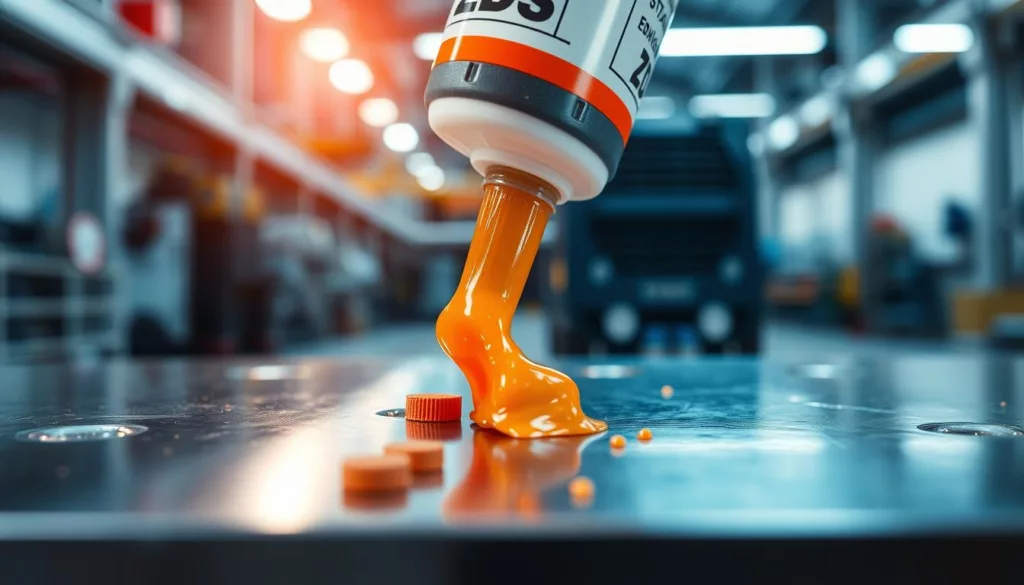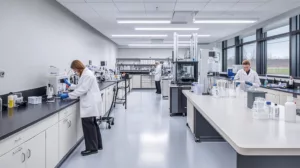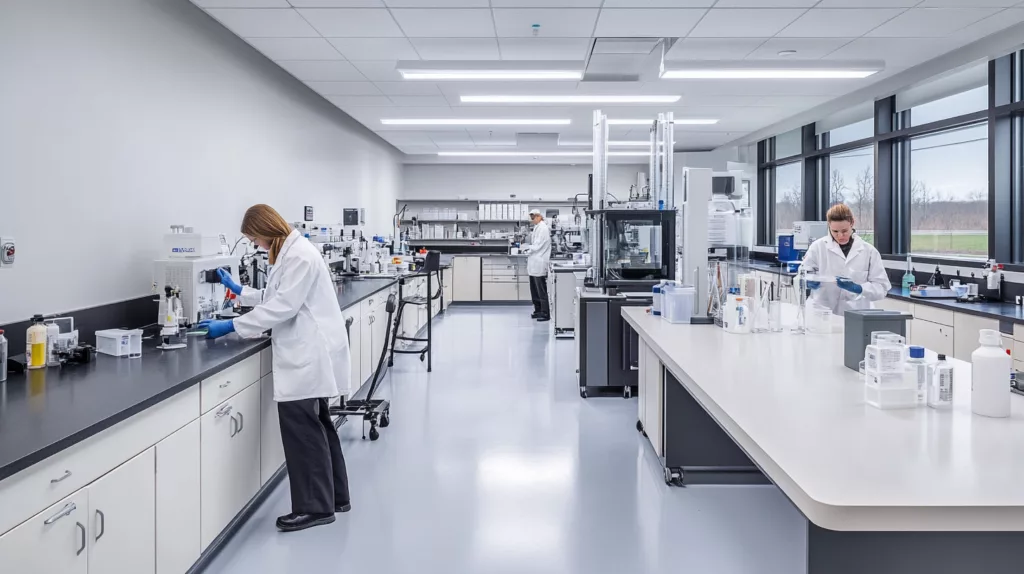Welcome to our guide on industrial adhesive for bonding plastics and metals. Choosing the right adhesive is key in today’s competitive world. This guide helps you understand the best adhesives for plastics and metals. You’ll learn about the top options for reliable connections in manufacturing and repairs.
Key Takeaways
- Explore various industrial adhesives for plastic and metal bonding.
- Understand the unique characteristics of plastic bonding glue.
- Learn about the best practices for selecting metal adhesive for industrial use.
- Recognize the importance of surface preparation for optimal adhesion.
- Identify common challenges in bonding different materials and viable solutions.
- Prioritize testing adhesive strength and environmental considerations in your applications.
Introduction to Industrial Adhesives
Industrial adhesives are key in bonding different materials, mainly in making and fixing things. They help create strong bonds between plastics and metals. This is important for many uses. Knowing about these adhesives helps us use them better in various fields.
What Are Industrial Adhesives?
Industrial adhesives are special mixes made to stick different materials together. They come in liquids, tapes, and films, depending on what you need. For example, picking the right glue for plastic and metal matters a lot. You need to think about the materials and how they will be used.
Importance in Manufacturing and Repair
Industrial adhesives play a big role in making things. They make products last longer and help make things faster by not needing screws. When fixing things, the right glue is very important. It makes repairs last longer and work better. New kinds of adhesives, like those in advanced adhesive solutions, make bonding even better for important jobs.
Types of Industrial Adhesives
Knowing about the different industrial adhesives is key for good bonding. Each type has its own use and benefits. Let’s look at epoxy, polyurethane, and acrylic adhesives.
Epoxy Adhesives
Epoxy adhesives are known for their strength and durability. They create strong bonds and resist chemicals and temperature changes well. This makes epoxy great for tough applications, ensuring bonds last in harsh conditions. It’s often the best choice for bonding plastics.
Polyurethane Adhesives
Polyurethane adhesives are flexible and strong. Their flexibility helps them absorb stress and move with surfaces. They’re a reliable choice for bonding metals, adding durability and flexibility.
Acrylic Adhesives
Acrylic adhesives dry fast and are clear. They’re perfect for projects where looks matter. They bond plastics and metals well, keeping the surface smooth and attractive. They’re another good option for bonding plastics and metals.
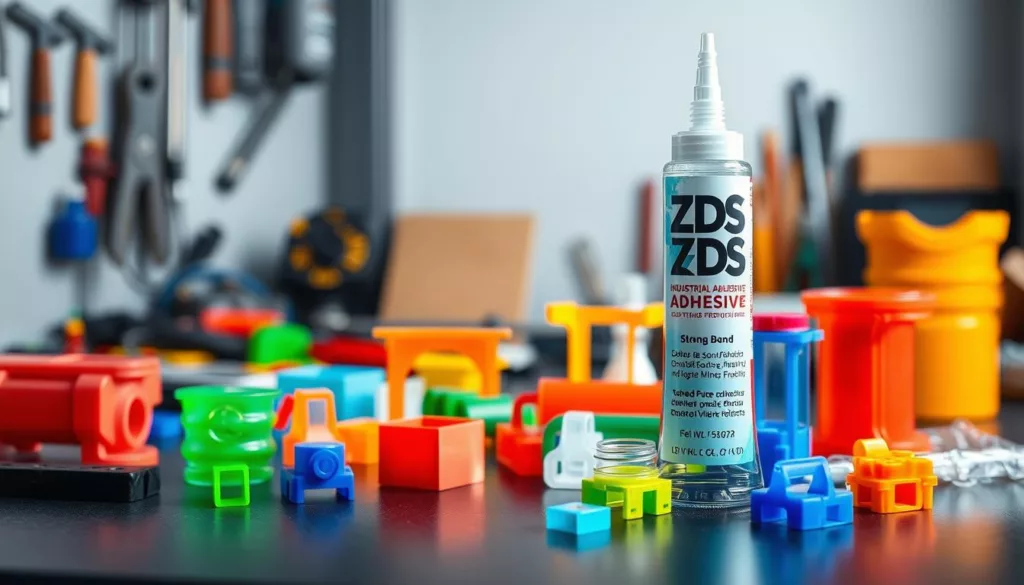
| Type of Adhesive | Strength | Flexibility | Ideal Applications |
|---|---|---|---|
| Epoxy | High | Low | Heavy-duty bonding, chemical resistance |
| Polyurethane | Moderate to High | High | Flexible applications, shock absorption |
| Acrylic | Moderate | Moderate | Aesthetic applications, fast curing |
Choosing the Right Adhesive for Your Application
Choosing the right adhesive is key to a strong and lasting bond. It’s important to consider several factors. This ensures the adhesive works well with both plastics and metals.
Factors to Consider
- Material Compatibility: Make sure the adhesive bonds well with plastics and metals.
- Environmental Conditions: Think about the temperature, humidity, and chemicals it might face.
- Strength Requirements: Decide how strong the bond needs to be for your project.
Application Methods
Knowing about different application methods can make bonding easier. You can use simple manual methods or advanced automated systems. Choosing the right method for your adhesive is important for the best results.
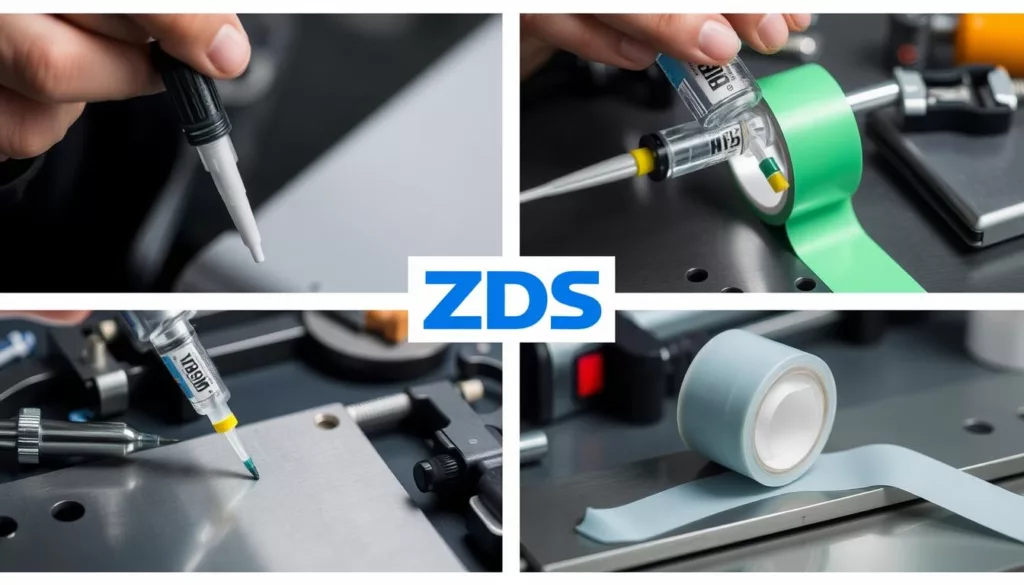
| Factor | Consideration | Recommended Action |
|---|---|---|
| Material Compatibility | Select an adhesive that bonds well with specific plastics and metals | Test different adhesives on sample materials |
| Environmental Conditions | Consider temperature and chemical exposure | Choose specialized adhesives for challenging environments |
| Strength Requirements | Define the bond strength needed for application | Consult product specifications for appropriate options |
Surface Preparation for Bonding
Getting surfaces ready is key for a strong bond with industrial adhesives. Clean, degreased, and roughened surfaces help the adhesive stick better. This makes the bond last longer.
Cleaning and Degreasing
To get a strong bond, you must remove dirt and oils. This cleaning process includes:
- Removing dirt, dust, and debris from the surfaces.
- An effective degreasing solution that eliminates oil and grease.
- Using lint-free cloths to prevent introducing new contaminants.
Surface Roughening Techniques
Roughening surfaces can also boost adhesion. Here are some ways to do it:
- Sanding the surfaces to create a textured finish.
- Using chemical etching agents that roughen the surface at a microscopic level.
- Implementing abrasive blasting for tougher materials requiring more aggressive treatment.
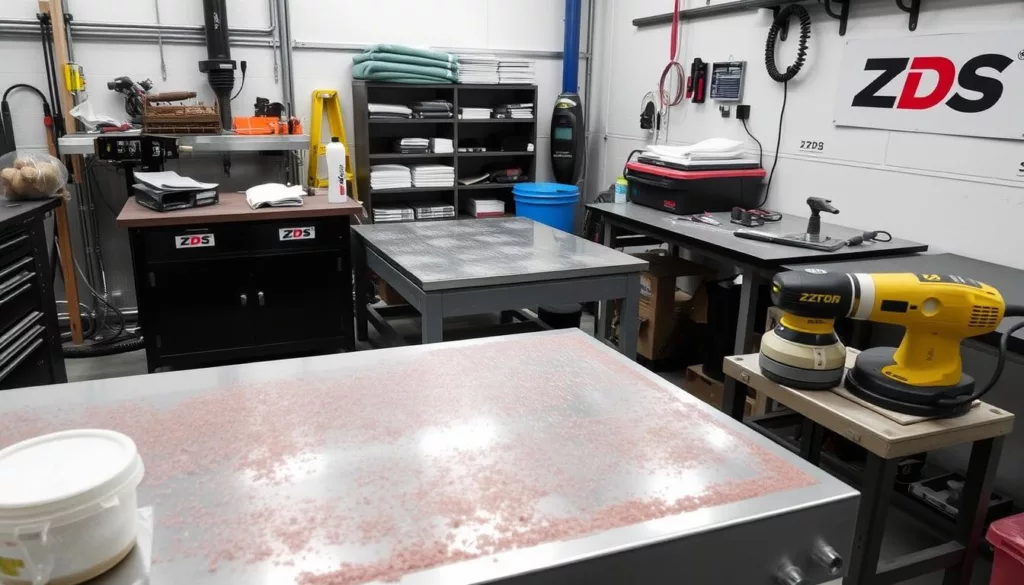
Bonding Plastics: Challenges and Solutions
Bonding plastics is tricky because of the many types available. Each type has its own challenges. Knowing these can help pick the right glue for bonding.
Types of Plastics
There are several plastics out there:
- Acrylics: These are clear and stiff. They need adhesives that dry clear to keep things looking good.
- Polyethylene and Polypropylene: These plastics are hard to bond because they don’t stick well. Special glues are needed for a strong bond.
Common Adhesives for Plastic Bonding
Choosing the right glue is key for bonding plastics. Here are some popular ones:
- Cyanoacrylate: Great for quick bonding on different plastics.
- Specialty Epoxies: Made for better bonding with certain plastics. They ensure the bond lasts long and is strong.
Using common adhesives for plastic bonding that match the plastic type can greatly improve the bond’s strength and life.
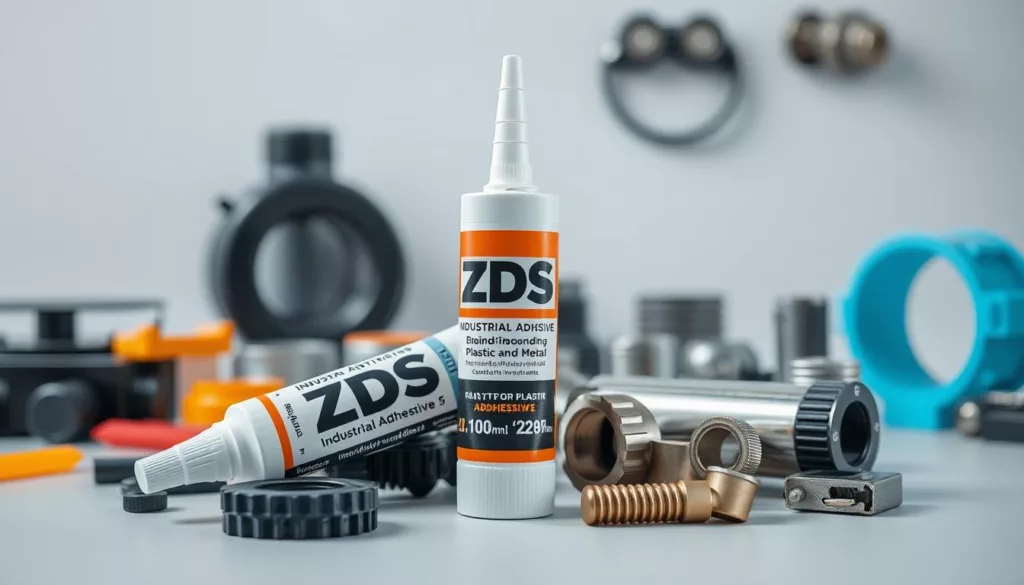
Bonding Metals Effectively
Understanding the types of metals used in different applications is key. Metals like aluminum, steel, and brass have unique properties. These properties affect the choice of adhesives and bonding techniques.
The surface finishes and how easily metals oxidize add complexity. This makes bonding metals a challenging task.
Types of Metals
Different metals need different bonding methods. Here are some metals commonly used in industry:
- Aluminum: Known for its lightweight and corrosion resistance.
- Steel: Offers high strength and structural integrity.
- Brass: Valued for its machinability and aesthetic appeal.
Selecting the Right Adhesive for Metal
Choosing the right adhesive is critical for success. A metal adhesive for industrial use is designed for these materials. It ensures durability and resistance to environmental factors.
High-strength epoxies are often the best choice. They provide exceptional bonding capabilities. For mixed materials, a strong adhesive for plastic and metal is also beneficial.
In our guide on choosing the right adhesive, we provide detailed insights. This knowledge helps make informed decisions when bonding metals. Visit our guide to learn more about suitable adhesives and best practices.

| Metal Type | Common Applications | Recommended Adhesive |
|---|---|---|
| Aluminum | Aerospace, automotive components | High-performance epoxy |
| Steel | Construction, machinery | Structural epoxy adhesive |
| Brass | Electrical connectors, decorative items | Metal bonding adhesive |
Testing Adhesive Strength and Durability
Knowing how strong and durable adhesives are is key in making things and fixing them. It’s important to use good testing methods to make sure adhesives meet quality standards and last long. There are many ways to check how well an adhesive works, each one focused on different things.
Standard Testing Methods
There are several standard tests that help us understand how adhesives perform. Some of the main ones are:
- Tensile Testing: This test shows how much weight an adhesive bond can hold when pulled apart. It tells us the highest force the bond can handle.
- Shear Testing: This test checks if the bond can resist forces that might make the materials slide apart. It’s very important for situations where there’s sideways stress.
Importance of Adhesive Performance Testing
Testing how well adhesives perform is very important for engineers and manufacturers. It gives them important info about how long the adhesive will last and if it’s right for different uses. This info helps them choose the right adhesive and how to use it, making things more reliable and efficient.
| Testing Method | Purpose | Key Parameters Measured |
|---|---|---|
| Tensile Testing | Measures adhesive strength under tension | Maximum load, elongation, failure point |
| Shear Testing | Evaluates resistance to sliding forces | Shear strength, displacement |
Environmental Considerations
We understand the need to reduce the environmental impact of adhesives. Traditional adhesives often have harmful chemicals that affect health and nature. Our goal is to make bonding technologies more eco-friendly.
Impacts of Adhesive Use on Health and Safety
Some adhesives release harmful gases when they dry. These gases can pollute the air and harm people’s health. We aim to create safer workspaces and protect everyone’s health.
Sustainable Adhesive Options
There’s a growing need for eco-friendly adhesives. New options include:
- Water-based adhesives: These are safer for workers and the planet because they don’t release harmful gases.
- Bio-based adhesives: Made from plants, they’re better for the environment and work well.
- Low-emission adhesives: These release fewer harmful gases, meeting strict environmental standards.
Switching to these options helps reduce harm to the environment while keeping bonding strong.
| Type of Adhesive | Environmental Impact | Performance Characteristics |
|---|---|---|
| Water-based Adhesives | Low VOC emissions, eco-friendly | Good adhesion, flexible |
| Bio-based Adhesives | Renewable materials, biodegradable | Strong bonding, effective in various applications |
| Low-emission Adhesives | Reduced VOCs, healthier indoor air quality | High durability, suitable for industrial use |
Choosing these options helps us meet regulations and supports a greener future for our industry and the planet.
Conclusion and Best Practices
The world of industrial adhesives for plastic and metal is full of options. There are many adhesive solutions for different needs. Knowing about the types of adhesives and how to prepare surfaces is key to making good bonds.
Recap of Key Points
Getting reliable bonds is all about a few important steps. Clean and rough surfaces are vital for adhesives to work well. Also, picking the right adhesive for your materials and needs is critical.
Tips for Successful Bonding
For the best results, follow best practices and keep up with new adhesive tech. Staying updated and adjusting your methods can lead to better bonds. This helps in creating custom solutions for specific needs. These tips can help both pros and DIY fans improve their work.
FAQ
What is the best industrial adhesive for plastic and metal bonding?
For plastic and metal bonding, a high-strength epoxy adhesive is often the best choice. It offers great durability and chemical resistance. But, different situations might need other types like polyurethane or acrylic adhesives.
How do I choose the right plastic bonding glue?
Choosing the right glue for plastic involves looking at material compatibility, environmental conditions, and bond strength. It’s key to pick adhesives made for the plastic type you’re working with.
Can metal adhesive for industrial use bond plastic effectively?
Yes, some metal adhesives for industrial use can bond plastic well. They need to be made to work with both materials. Always pick an adhesive that fits your specific needs.
What are common challenges in bonding plastics and metals?
Challenges include surface energy differences, material expansion and contraction, and adhesion failures from contaminants. Good surface prep and the right adhesive can solve these problems.
What adhesive bonding solutions are available for industrial use?
There are many solutions like cyanoacrylate, epoxies, and polyurethane adhesives. Each has special properties for different plastic and metal combinations, based on strength and application needs.
How important is surface preparation when bonding plastics and metals?
Surface prep is key for strong bonds. Cleaning, degreasing, and roughening surfaces helps adhesives stick better. It removes contaminants and increases bonding area.
What is the difference between epoxy and acrylic adhesives?
Epoxy adhesives are very strong and durable, with great chemical resistance. Acrylic adhesives cure fast and are clear, perfect for looks. Each has its own use based on material and condition.
What testing methods are used to evaluate adhesive strength?
To test adhesive strength, we use tensile and shear tests. Tensile tests check how much load a bond can take. Shear tests see if the adhesive can resist sliding forces.


